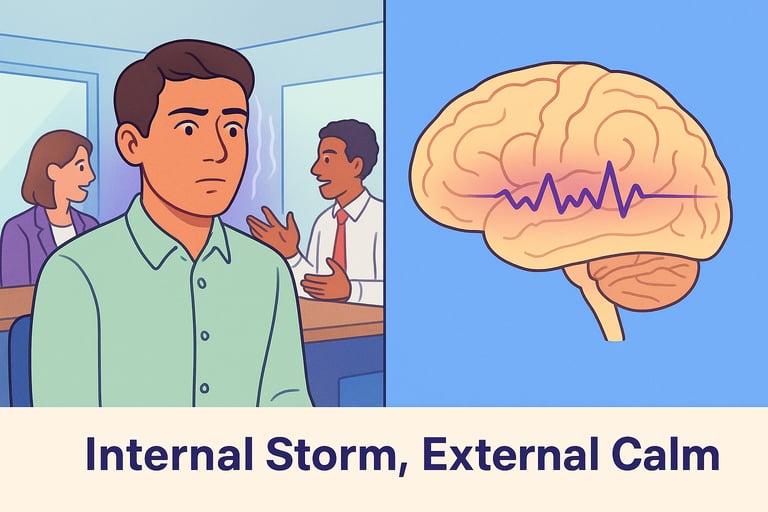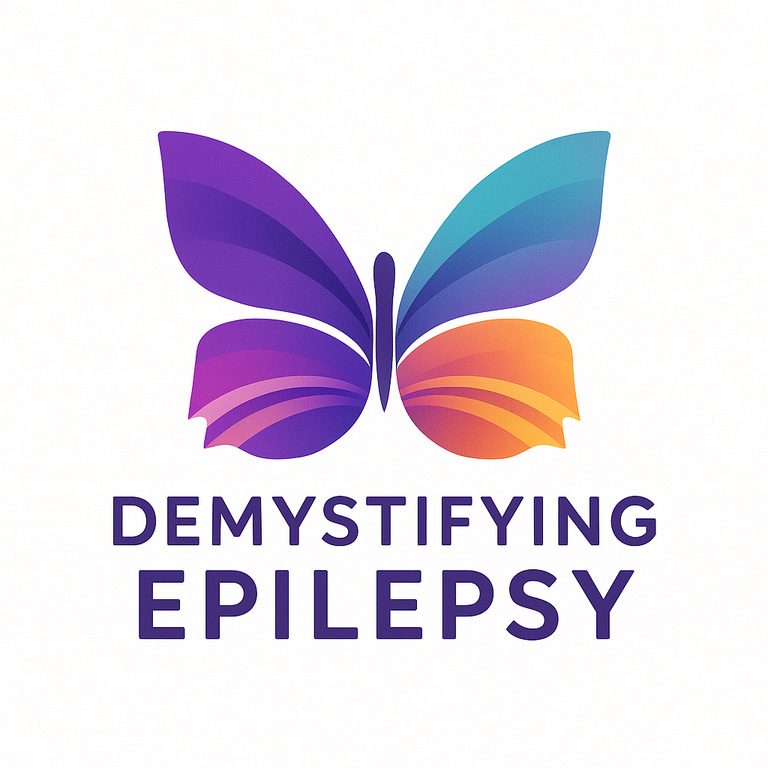Understanding Focal Aware Seizures: Meet Jorge
Focal aware seizures (previously called “simple partial seizures”) occur when a person remains fully aware during the seizure even though unusual electrical activity is taking place in one part of the brain. This blog explains what focal aware seizures look like, how they’re diagnosed, what causes them, and how they can be managed. Through the story of Jorge, a young man navigating life, work, and his seizures, you’ll gain insight into the experience and practical tips for support, safety, and hope.
Dr. Clotilda Chinyanya
11/26/20254 min read


Jorge’s Story
Jorge was 22 and working as a graphic designer when he first noticed something strange. He was reviewing a client’s logo late one evening when his hand began tingling. At first, he dismissed it as fatigue from deadlines. But then his right arm jerked uncontrollably for a moment, and this time he was fully awake and aware. He paused, eyed his mug of coffee, and noticed a faint buzzing in his mind, like static in the background.
Over the next few weeks, the episodes became more frequent. Sometimes he’d be driving home and suddenly feel his vision flicker like lights dancing at the edge of his sight. Other times his stomach would churn uncontrollably, or he’d feel a wave of déjà vu. In each case, he was conscious and aware of his surroundings, even though something felt “off.” He continued working and living his life, but he worried about how others would perceive him if they noticed these odd moments.
Finally, he went to see a neurologist who explained that Jorge’s symptoms were likely focal aware seizures, previously called “simple partial seizures.” Unlike seizures that cause loss of consciousness, these begin in one side of the brain and leave awareness intact, though the experience may be disconcerting. Hearing this gave Jorge language for what he was going through, and a plan for moving forward.
With guidance, Jorge began treatment with anti-seizure medications and learned to track his triggers: lack of sleep, stress, skipping meals. He also shared his story with his team at work, adjusting his schedule and preparing for his safety. Over time, his seizures reduced in frequency and his confidence grew. Today, Jorge continues his design work with passion. He also mentors others with epilepsy and shows that awareness, support, and action matter.
What Are Focal Aware Seizures?
When a seizure originates in a specific region of one side of the brain and a person remains conscious and aware of their surroundings, clinicians call it a focal aware seizure (formerly “simple partial seizure”). During such an event, you might feel unusual sensations, jerking of a limb, changes in emotion, or a sense that something is happening, yet you stay alert.
What Does Awareness Mean, and Why Does It Matter?
Awareness here means that during the seizure you recognize your environment and may recall it afterward. That distinguishes focal aware seizures from focal impaired awareness seizures (previously “complex partial seizures”), where consciousness is altered or lost. Because the person remains alert, these seizures often go unrecognized or misinterpreted as migraines, anxiety, or movement disorders.
What Do These Seizures Look Like?
Symptoms depend on which brain region is involved. Some examples:
A sudden jerking or stiffening of a limb
A tingling or crawling sensation in one part of the body
Visual or auditory changes (flashing lights, unusual sounds)
Emotional shifts, such as sudden fear or déjà vu
Autonomic signs: feeling nauseated, heart racing, stomach churning
Sensory symptoms like certain distinctive smells, for example, a burning smell
The episodes are usually brief, often under two minutes, and may leave little or no after-effect other than curiosity or concern. Because they are subtle, many people do not report them until the events become disruptive or frequent.
Who Is at Risk?
Everyone can experience a focal aware seizure, although certain factors raise the chance:
Prior head injury, stroke, brain infection or tumor
Known epilepsy or a family history
Structural brain changes
Metabolic conditions
In many cases, no clear cause is found. The important part is recognizing the patterns, not necessarily finding a dramatic explanation.
Why Do They Occur?
In the brain, electrical signals coordinate our thoughts, movements, and sensations. A focal aware seizure is triggered when a small group of neurons start firing abnormally in one area, interrupting the usual flow yet not spreading widely enough to affect full consciousness. For example, if the seizure starts in the part of the brain controlling the hand, you might feel your hand jerk but you remain aware and able to describe exactly what happened.
How Are They Diagnosed?
Diagnosis is multifaceted and may include:
A detailed history and description of the events (when, what, how)
A video-EEG (electroencephalogram) test to detect abnormal brain waves during events
MRI or CT scans to look for structural brain causes
Additional testing (blood work, heart monitoring) to rule out other conditions
Since awareness is preserved, some events may seem too “mild” to be seizures, which is why witnessing and recording episodes (video or detailed notes) is very helpful.
What Treatment Options Exist?
Treatment is tailored to the person and the underlying condition. Options include:
Anti-seizure (anti-epileptic) medications
Dietary therapies or lifestyle adjustments
Devices or surgical options for cases not controlled by medications
Importantly, treatment is not one-size-fits-all. Treatment depends on how often the seizures occur, how they affect daily life, and whether they progress into other seizure types.
What Should You Do If You or Someone Else Has One?
Unlike convulsive seizures, the person will likely stay conscious and may even continue talking. Still:
Ensure they are in a safe environment (remove hazards)
You may ask calmly if they are okay but avoid startling them
If it is the first episode or changes in usual pattern, seek medical evaluation
Track the symptoms: when they happened, how long, what you were doing
Jorge’s Experience: Applying the Knowledge
When Jorge first felt that tingling hand, he chose not to ignore it. He kept a journal with dates and descriptions. He brought a short video recorded by his colleague to his neurologist. That gave his doctor crucial information. When treatment began, Jorge also changed some of his routines: better sleep hygiene, stress-reduction, adjusting his workload. He informed his team that he might pause briefly if unusual sensations occurred. This openness reduced his anxiety and increased his safety.
Living Well with Focal Aware Seizures
Having awareness during a seizure is both a gift and a challenge. Because you stay awake, you may feel everything that happens, like the jolting limb, the odd sensation, the awkward moment, or the strange smell. Retention of awareness helps you respond, describe what happened, and keep yourself safe.
Tips for better living:
Share your diagnosis with trusted people so they understand what you go through
Keep a seizure diary of triggers, patterns, timing
Consider lifestyle modifications: enough sleep, minimal alcohol, stress control
Educate teachers, coworkers, family so you are not misunderstood
Prioritize safety: avoid high-risk activities when unsupervised if your seizures are uncontrolled
Final Thoughts
Focal aware seizures may be brief and subtle, but they matter. They offer a window into the brain’s complexity and can signal a larger epilepsy picture. With awareness, support, and appropriate treatment, people like Jorge not just manage the seizures, they thrive.
If you or someone you love experiences unusual sensations, jerks, or “strange moments,” don’t dismiss them. Talk to a neurologist or epilepsy specialist. Early understanding means better control. You are not alone. You are capable. And with the right care, seizures are just one part of your story, but they don’t define you.
Further Reading:
Choose Knowledge:
